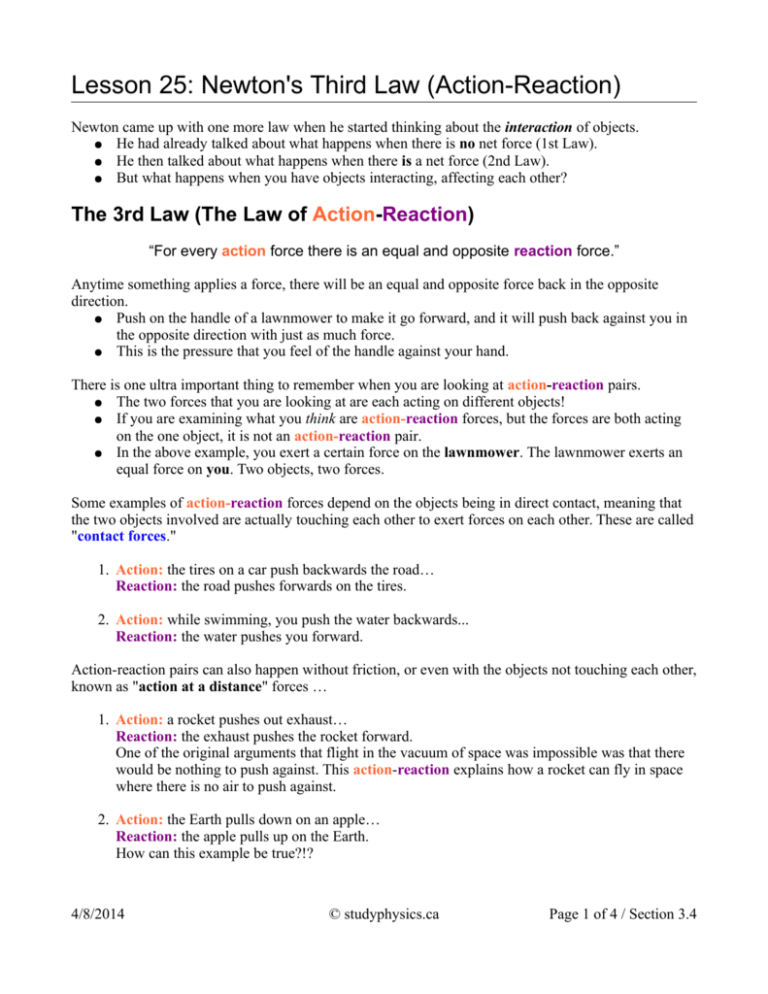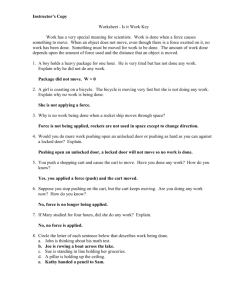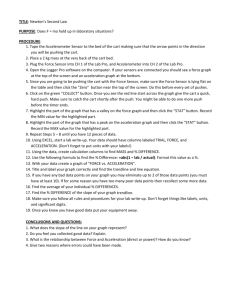Newton's Third Law (Action-Reaction)
advertisement

Lesson 25: Newton's Third Law (Action-Reaction) Newton came up with one more law when he started thinking about the interaction of objects. ● He had already talked about what happens when there is no net force (1st Law). ● He then talked about what happens when there is a net force (2nd Law). ● But what happens when you have objects interacting, affecting each other? The 3rd Law (The Law of Action-Reaction) “For every action force there is an equal and opposite reaction force.” Anytime something applies a force, there will be an equal and opposite force back in the opposite direction. ● Push on the handle of a lawnmower to make it go forward, and it will push back against you in the opposite direction with just as much force. ● This is the pressure that you feel of the handle against your hand. There is one ultra important thing to remember when you are looking at action-reaction pairs. ● The two forces that you are looking at are each acting on different objects! ● If you are examining what you think are action-reaction forces, but the forces are both acting on the one object, it is not an action-reaction pair. ● In the above example, you exert a certain force on the lawnmower. The lawnmower exerts an equal force on you. Two objects, two forces. Some examples of action-reaction forces depend on the objects being in direct contact, meaning that the two objects involved are actually touching each other to exert forces on each other. These are called "contact forces." 1. Action: the tires on a car push backwards the road… Reaction: the road pushes forwards on the tires. 2. Action: while swimming, you push the water backwards... Reaction: the water pushes you forward. Action-reaction pairs can also happen without friction, or even with the objects not touching each other, known as "action at a distance" forces … 1. Action: a rocket pushes out exhaust… Reaction: the exhaust pushes the rocket forward. One of the original arguments that flight in the vacuum of space was impossible was that there would be nothing to push against. This action-reaction explains how a rocket can fly in space where there is no air to push against. 2. Action: the Earth pulls down on an apple… Reaction: the apple pulls up on the Earth. How can this example be true?!? 4/8/2014 © studyphysics.ca Page 1 of 4 / Section 3.4 Example 1: If the apple has a mass of 0.150 kg, determine the acceleration of the Earth. ● There is an action-reaction pair of forces given by Fa = - FE ● We know that the apple will accelerate towards the earth at 9.81 m/s2, but does the Earth accelerate towards the apple at the same rate? ● If this were true you would expect the earth to be constantly jumping up towards falling objects. ● Carefully remember Newton’s Second Law (F = ma). In this example the forces are equal, but the mass of the earth is considerably larger than the apple! ● The earth has more inertia than the apple, so the same force will only accelerate it a little bit. The Force of the Earth on the Apple E F a =ma=mg E F a=0.150(−9.81) E F a=−1.4715 N This is the force of the Earth acting on the apple, but because of Newton’s Third Law, it is also the force of the apple on the Earth, just in opposite directions. EFa = -1.4715 N aFE = 1.4715 N The Acceleration of the Earth because of the Apple a F E =ma Did You Know? Sir Isaac Newton was uncomfortable with his own theories about gravity being an “action at a distance” force. He believed so strongly that there must be some material that connects objects that have a gravitational pull on each other, that he was one of the first scientists to seriously suggest there was a mysterious substance called the aether (sometimes spelled ether) that connected all objects in the universe. F 1.4715 a= a E = m 5.97e24 a=2.46482e-25=2.46e-25 m/s 2 This is such a small acceleration of the Earth towards the apple that it can’t even be measured. We can see that although the forces are equal, the accelerations do not have to be. Example 2: When a rifle fires a bullet, the force the rifle exerts on the bullet is exactly the same (but in the opposite direction) as the force the bullet exerts on the rifle… so the rifle “kicks back”. The bullet has a mass of 15 g and the rifle is 6.0 kg. The bullet leaves the 75 cm long rifle barrel moving at 70 m/s. a) Determine the acceleration of the bullet. We will assume that the bullet is traveling forwards, while the rifle is moving backward. v 2f =v 2i + 2ad v 2f −v 2i a= 2d 70 2−0 a= 2(0.75) 2 ̄ a=3266. 6=3.3e3m/s The positive acceleration shows that the bullet is speeding up while traveling forwards. 4/8/2014 © studyphysics.ca Page 2 of 4 / Section 3.4 b) Determine the force of the rifle on the bullet. ̄ )=49N F b=mb ab=0.015(3266. 6 c) Determine the acceleration of the rifle. F b=49 N F r =−49N F r =mr ar F r −49 ar = = mr 6.0 ̄ =−8.2m/s 2 ar =−8.1 6 The negative acceleration shows the rifle is speeding up while going backwards. d) Explain why the bullet accelerates more than the rifle if the forces are the same. Although have the same amount of force acting on them, they each have a different mass (and therefore a different inertia). Example 3: You just got a couple of identical 20.0 kg shopping carts to do some shopping. The reason you have two is that they are unfortunately stuck together. You push them into the store to get help pulling them apart. You are running towards the store accelerating the Illustration 1: Two shopping carts being shopping carts at 1.2 m/s2. Determine the force the pushed. second cart exerts on the first cart. ● You are pushing the first cart forward, and the first cart is pushing the second cart forward. That means that the second cart is pushing back on the first cart. ● We know the mass of the second cart and its acceleration, which takes a certain amount of force. As much as it takes that much force to push it forwards, it will push back just as hard on the first cart. Force pushing Cart Two forwards... F 2=m2 a2 F 2=20.01.2=24 N The notation 2F1 just means “the force of 2 acting on 1.” Force of Cart Two pushing back on Cart One... 2 F 1 =−24 N 4/8/2014 © studyphysics.ca Page 3 of 4 / Section 3.4 Example 4: Once you get in the store you see an employee pushing two boxes out of the stock room (see Illustration 2) to the Dog Food Dog 4.50 kg Treats right. The employee is pushing with a force 2.36 kg that causes the two boxes to accelerate at 1.12 m/s2. You know that the friction acting Illustration 2: Pushing two boxes to the right. on the box of dog treats is 14.8 N. Determine the force the dog treat box is applying against the dog food box. ● ● ● ● ● FN Draw a free body diagram of the box of dog treats. We can ignore the vertical forces since they balance out Ff Fa against each other. Remember that it is the net force that is resulting in the actual 1.12m/s2 acceleration of the box. If we can figure out the applied force moving the treats Fg forward (the dog food box pushing the treats), we will know how hard it is pushing back against the dog food. Illustration 3: Free body diagram of the box of dog FNET =FaFf treats. ma=F a F f 2.361.12=Fa −14.8 2.6432=Fa−14.8 F a =2.643214.8 F a=17.4432=17.4 N If it takes an applied force of 17.4 N to push the treats forward, it must be pushing back against the dog food just as hard with a force of -17.4 N. Example 5: If I push on a lawn mower, it pushes back on me with an equal, but opposite force. Explain why we don’t both just stay still. ● The answer is that these forces are acting on different bodies (and there are other forces to consider). ● It doesn’t matter to the lawn mower that there is a force on me… all that matters to the lawn mower is that there is a force on it, so it starts to move forward. ● Another action-reaction pair you Illustration 4: The two sets of action-reaction pairs in this need to consider is that I am situation. pushing backwards on the ground, and it pushes forwards on me. Homework p168 #2,5,7 4/8/2014 © studyphysics.ca Page 4 of 4 / Section 3.4







